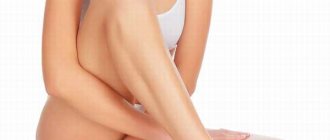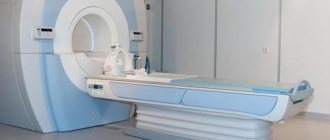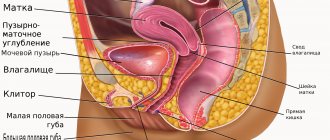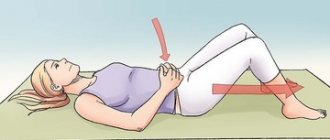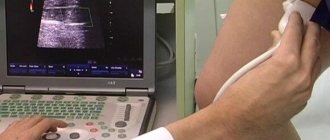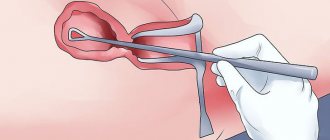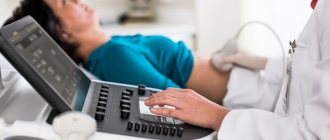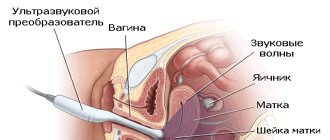Why is this happening?
Normally, the uterus and appendages are in a fixed state due to strong ligaments and muscles of the pelvic floor, but at the same time they remain mobile. During pregnancy, radical changes occur in a woman's hormonal background: the uterus increases in size, pulls ligaments and muscle fibers with it, and the abdominal muscles stretch. In a healthy woman, after childbirth, the uterus returns to its original position, and the muscular-ligamentous system returns to normal after a few months.
The muscular corset of the pelvis supports the organs of the genitourinary system in a physiological position. If during complicated childbirth and pregnancy, the ligamentous and muscular apparatus was subjected to tears and overstretching, then the organs are displaced to such an extent that they are not able to return to their normal position even a year or two after birth. This is the main reason for the displacement of the uterus towards the genital slit. The disease is called “genital prolapse” and has a number of characteristic symptoms.
Causes of cervical prolapse.
- More than 3 births in history.
- The age of the woman giving birth is over 35 years.
- Ruptures of the cervix and vagina during childbirth.
- Violation of the integrity of the pelvic muscles - this occurs due to increased pressure on them during pregnancy, which was accompanied by polyhydramnios, multiple pregnancies, and a large fetus.
- The risk group includes women with preeclampsia, diabetes mellitus in pregnancy, obesity, and isthmic-cervical insufficiency.
- If the birth was difficult - weakness of labor, pathological attempts, rapid labor, application of obstetric forceps - the risk of pathology increases several times.
- If a woman neglected the recommendations of doctors, lifted weights or was engaged in work associated with intense physical activity, the likelihood of developing cervical prolapse after childbirth increases. This applies to the uterus, and in some cases, the rectum.
- Poor nutrition - strict diets, strict vegetarianism, addiction to fast food, and as a result, a deficiency of essential microelements and protein often lead to complications after childbirth, the appearance of symptoms of uterine displacement.
- Chronic constipation.
- Developmental anomalies of the female genital organs.
- Genetic factor associated with connective tissue dysplasia.
Symptoms of genital prolapse can appear several months after the birth of a child and the pathology is more often diagnosed in middle-aged women.
Uterine prolapse and pregnancy
Many women, after suffering problems associated with uterine prolapse, worry about the future possibility of having children. And the danger lies not so much in conception as in bearing the fetus.
there is a real risk of miscarriage, miscarriage or premature birth. This occurs due to increased stress on the pelvic muscles.
To safely carry a child, you should use special prenatal bandages, as well as pessaries, which are devices that help keep the uterus in the correct position.
You should also be under the constant supervision of doctors and follow their recommendations.
Symptoms after childbirth
Often, when the uterus is displaced, a woman feels discomfort during sexual intercourse, when walking, playing sports, running, or lifting loads. They describe it as a feeling of fullness and pressure in the vagina. Many women do not pay special attention to unpleasant symptoms and consider them a normal occurrence.
Signs of uterine prolapse after childbirth:
- chronic aching pain in the lower abdomen is the first and one of the main signs of uterine prolapse;
- piercing pain in the vaginal area, sacrum and lower back - occurs as the disease progresses;
- severe discomfort during movement - such a symptom indicates that the uterus is already in an unusual place for it;
- urinary incontinence, frequent constipation, increased leucorrhoea;
- varicose veins of the lower extremities;
- discharge mixed with blood;
- discomfort during urination and defecation.
If one or more of these symptoms appears, you should immediately visit a doctor. Such signs may indicate not only uterine prolapse, but also other serious gynecological pathologies. Timely diagnosis and proper treatment will help avoid the development of severe complications.
What are the degrees of the disease?
It is customary to distinguish 4 degrees of uterine prolapse after childbirth:
- 1st degree: the onset of the disease, when the displacement of the organ occurs not completely, but partially beyond the normal limits. In this case, the cervix is mainly located at the level of the vagina. The woman does not feel discomfort, she may only be bothered by minor pain during sexual intercourse.
- 2nd degree: during vaginal tension, partial prolapse of the reproductive organ or cervix can be seen. Looks good.
- 3rd degree: prolapse of both the cervix and partial prolapse of the uterus itself is clearly visible. It brings severe discomfort to a woman both when moving and when sneezing and coughing.
- 4th degree: complete prolapse of the reproductive organ beyond the boundaries of the vagina.
4th degree uterine prolapse
Conservative treatment methods
If you consult a doctor when the first symptoms of cervical prolapse appear, treatment can be carried out using medications and other conservative methods. In advanced forms of the disease, surgical intervention will be required.
Methods of conservative treatment include special gymnastics, gynecological massage, installation of a special pessary and the use of medications with estrogens. The most effective drugs are Ovestin, Klimen, Tefestrol.
Massage of the uterus helps eliminate symptoms of prolapse at the initial stage. Daily massage procedures are performed, and the duration is determined by the doctor individually. Combined therapy has a high effect: massage, electrophoresis, magnetic therapy, acupuncture, therapeutic exercises and exercise therapy.
Sometimes a pessary is installed. A pessary is a vaginal ring made of safe plastic that performs supportive functions and makes the symptoms of uterine displacement less noticeable. It is installed in middle-aged women with moderate cervical prolapse and in the presence of contraindications to surgical intervention. The method has a number of side effects - trauma to the vaginal walls, heavy discharge. To reduce the risk of complications, estrogen hormone therapy is prescribed.
During the treatment of prolapse, it is necessary to minimize all physical activity, otherwise the therapy will be ineffective.
Surgery
If conservative treatment methods do not bring the desired result, the doctor will prescribe an operation that will preserve reproductive functions, but if the uterus has completely prolapsed, this will not be possible.
Types of surgical intervention:
- Colporrhaphy - during the operation, one wall of the vagina is sutured, which provides a good supporting effect.
- The use of alloplastic materials - through holes in the anterior abdominal wall, the round ligaments are shortened and strengthened using a nylon mesh.
- Trimming the pelvic floor muscles prevents further displacement of the uterus.
If simple operations are ineffective and complete prolapse of the uterus has occurred, the doctor is no longer faced with the task of preserving reproductive functions. The uterus can be completely removed, but this is the most extreme measure in treating prolapse.
If you do not start timely treatment for cervical prolapse, problems with the intestines, bladder, and inflammatory processes of the genitourinary system may occur.
Possible consequences
Lack of treatment and timely diagnosis will lead to complete loss, which should not be allowed under any circumstances. Also, when treating an advanced disease, the sensitivity of the vagina is seriously affected, since surgery inevitably affects it too. Find out more about erosion, dysplasia, colposcopy and leukoplakia of the cervix. Stopping the production of sex hormones leads to early menopause and many psychological problems. In general, the old truth is justified here: it is better to prevent the occurrence of a disease than to treat it later.
Did you know? In the ninth month of pregnancy, the volume of the uterine cavity becomes 500 times larger than the original.
Set of exercises
If the cervix has dropped after childbirth, it is necessary to do special exercises that will help eliminate the symptoms of the disease. Some exercises can be done while sitting at work, driving a car, or standing in line.
Gymnastics for uterine prolapse:
- Squeeze your vaginal muscles, count to 10, relax, repeat after 10 seconds. Do the exercise 12–15 times, gradually increasing the duration of muscle tension.
- Sharp compression and relaxation of muscles at a fast pace; you need to do at least 10 repetitions, gradually increasing their number to 50.
- Slowly tense and relax the vaginal muscles without delay. Do 10 repetitions.
The usual exercises – “bicycle”, “scissors”, “birch tree” - also help well in the treatment of uterine prolapse; they will help in the treatment of the disease.
Folk remedies
There are many effective alternative medicine recipes that help strengthen the pelvic muscles, but they should only be used in combination with drug therapy and gymnastics.
Effective traditional medicine:
- Datura. Immerse 20 crushed dope leaves in 5 liters of boiling water and simmer the mixture over low heat for a quarter of an hour. Use the decoction for sitz baths, the duration of the procedure is 15–20 minutes.
- Dymyanka. Pour 1 liter of hot water 1 tbsp. l smoker, leave in a closed container for 8–9 hours, filter. Drink 120 ml three times a day half an hour before meals.
- Astragalus. Grind 20 g of astragalus root, pour in 180 ml of vodka, leave for a week in a dark room, filter. Take 5 ml 3 times a day before meals. This treatment method is not suitable for breastfeeding women.
- Quince. Grind 100 g of quince, add 1 liter of water, cook for 25 minutes over low heat, strain. Use warm for douching - carry out the procedure every evening for a week, you can continue treatment after a seven-day break.
You should not prescribe medications for your own treatment. The use of any folk remedies must be coordinated with your doctor, since even seemingly safe herbs can cause the development of various complications.
How to prevent
To avoid the appearance of symptoms of uterine displacement after childbirth, it is necessary to prevent the disease before pregnancy and directly during pregnancy.
If a woman has a history of uterine prolapse after childbirth, she must inform the doctor about this - in such cases, obstetricians use more gentle methods of delivery.
The set of exercises that are used to eliminate the manifestations of prolapse is also suitable for preventing the disease - if you regularly train the muscles, it will be easier for them to withstand increased loads during pregnancy. But immediately after giving birth, you should consult a gynecologist about the advisability of performing gymnastics - physical activity is not always safe during this period.
The main methods of prevention are proper nutrition, taking vitamin complexes, daily walking at a moderate pace, doing yoga or special gymnastics for pregnant women. Women are not recommended to stand on their feet for a long time, lift heavy objects, or push hard during bowel movements; if constipation occurs, it must be treated with medications and diet.
Uterine prolapse after childbirth is diagnosed in 10% of women. Symptoms of the disease can be vague for a long time, so many people go to the doctor with advanced forms of the pathology, which makes treatment much more difficult. Simple prevention methods and regular visits to the gynecologist will help prevent uterine prolapse after childbirth, or identify it in the early stages of development.
Prevention
Don't forget that most diseases can be prevented. To do this, you need to follow basic rules of prevention. In the case of uterine prolapse, we know that such pathology occurs after pregnancy and childbirth. Knowing this, you need to prepare in advance for this stage in life. Besides, it's not that difficult. To do this, just consult a doctor, and he will tell you a list of recommendations for pregnant women that you will need to follow.
It is worth remembering once and for all that during pregnancy, a young mother is prohibited from performing any physical activity. This also applies to the postpartum period. In the first month after birth, it is better not to hold the baby in your arms while standing. Feeding should also be done while sitting.
An equally important preventive action is preparing the uterus and its muscles for childbirth. To do this you need to perform a special set of exercises. In addition, this method can also be used to treat displacement.
